Themed collection Pioneering Investigators 2023

Introduction to Pioneering Investigators 2023
Professor Holger Frey and Professor Emily Pentzer introduce the 2023 Polymer Chemistry Pioneering Investigators collection.

Polym. Chem., 2024,15, 1905-1907
https://doi.org/10.1039/D4PY90043J
Mechanically induced chemiluminescence of xanthene-modified 1,2-dioxetane in polymers
Xanthene-modified 1,2-dioxetane (Xa-Ad) derivatives were designed and synthesized using a facile protocol, and their mechanical activity was identified for the first time to the best of our knowledge.

Polym. Chem., 2023,14, 4148-4152
https://doi.org/10.1039/D3PY00786C
An electrochemical Hofmann rearrangement on acrylamide copolymers
Constant current electrolysis of acrylamide copolymers promotes a mild and efficient electrochemical Hofmann rearrangement transforming the primary amide side-chains into O-methyl carbamate side-chains in methanol.

Polym. Chem., 2023,14, 3057-3062
https://doi.org/10.1039/D3PY00594A
3D-printed ketoenamine crosslinked polyrotaxane hydrogels and their mechanochromic responsiveness
We report the synthesis and 3D printing of mechanically robust ketoenamine-crosslinked polyrotaxane hydrogels. These hydrogels are tagged with molecular probes to show fluorescent emission changes upon compression.

Polym. Chem., 2023,14, 2159-2163
https://doi.org/10.1039/D3PY00337J
Oxygen-tolerant, eosin Y mediated synthesis of protein–polymer biohybrids and protein-coated polymer nanoparticles
An oxygen tolerant, eosin Y/TEMED mediated, photoinduced polymerization approach was optimized to graft hydrophobic, hydrophilic, and responsive polymers from protein macroinitiators, avoiding conventional metal catalysts.

Polym. Chem., 2024,15, 3246-3255
https://doi.org/10.1039/D4PY00407H
Optimizing stability through conformational locking and ring fusion modulation in organic semiconductors
S,N-Heteroacene-type fused tetrathienophenanthroline monomer was synthesized via intramolecular cyclization, an alternative to the raditional benzodithiophene-4,8-dione units in high-performance photovoltaic materials.

Polym. Chem., 2024,15, 3010-3017
https://doi.org/10.1039/D4PY00246F
Exploiting controlled transesterification as a “top down” approach to tailor poly(ε-caprolactone)-poly(lactic acid) copolymer structures with bis-Zn catalysts
Mediated by a bis-Zn catalyst, poly(lactic acid)-block-poly(ε-caprolactone) diblock copolymers can be modified via controlled transesterification, leading to diverse copolymer structures.

Polym. Chem., 2024,15, 1704-1713
https://doi.org/10.1039/D4PY00169A
A direct comparison between ring-opening copolymerization and polycondensation to produce polyesters using poly(ethylene succinate) as an example
A direct comparison between ROCOP and polycondensation to produce polyesters was made using PES, by evaluating the monomer preprocessing, polymerization technique, post-processing, and the properties of the produced polyesters.
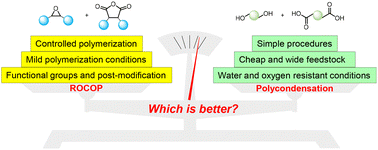
Polym. Chem., 2024,15, 412-421
https://doi.org/10.1039/D3PY01314F
From RAFT emulsion polymerization to RAFT dispersion polymerization: a facile approach to tuning dispersities and behaviors of self-assembled block copolymers
We have demonstrated the successful transition from photoinitiated RAFT emulsion polymerization to photoinitiated RAFT dispersion polymerization by solely changing the solvent composition from water to water/ethanol.
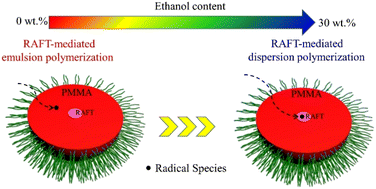
Polym. Chem., 2024,15, 106-117
https://doi.org/10.1039/D3PY01006F
Efficient all polymer active layers with long-range ordered 1D p–n nanoheterojunctions confirmed by TEM tomography
Using crystallization-driven polymer assemblies in non-halogenated solvents allows for precise control of the 3D morphology of the photoactive layer, thus improving the efficiency and stability of all-polymer solar cells.

Polym. Chem., 2023,14, 5040-5048
https://doi.org/10.1039/D3PY00718A
Photoredox Diels–Alder ladder polymerization
Ladder polymers with highly saturated backbones are prepared using a photoredox-catalyzed radical cation Diels–Alder polymerization.

Polym. Chem., 2023,14, 4906-4911
https://doi.org/10.1039/D3PY00833A
Insight into the melt-processed polylimonene oxide/polylactic acid blends
The addition of a small amount of PLO to PLA by melt processing leads to a decrease in the PLA's Tg, Tm and degree of crystallinity as well as a remarkable increase in PLA films flexibility. The strong interactions between PLO and PLA is unveiled.

Polym. Chem., 2023,14, 4530-4537
https://doi.org/10.1039/D3PY00667K
RAFT polymerization of an aromatic organoborane for block copolymer synthesis
We report the synthesis and characterization of PS-b-PVA block copolymers (BCPs) with tailorable PVA block lengths via RAFT polymerization of an aromatic organoborane comonomer BN 2-vinylnaphthalene (BN2VN).
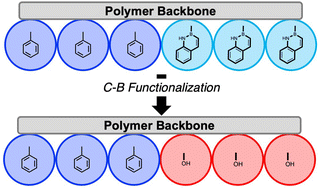
Polym. Chem., 2023,14, 4454-4464
https://doi.org/10.1039/D3PY00706E
Thermoresponsive behaviour of poly(N,N-diethylacrylamide) in aqueous two-phase systems
The thermoresponsive behaviour of poly(N,N-diethylacrylamide) can be tuned when the polymer is placed in an aqueous-two phase system.

Polym. Chem., 2023,14, 4101-4108
https://doi.org/10.1039/D3PY00734K
Exploiting the network architecture of thiol–ene photo-crosslinked poly(ε-caprolactone) towards tailorable materials for light-based 3D-printing
Thiol–ene photo-crosslinked poly-ε-caprolactone networks, exhibiting varying network architectures, were employed to fine-tune physico-chemical characteristics, while simultaneously exploring their potential application in digital light processing.
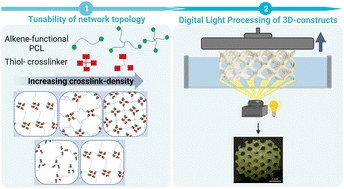
Polym. Chem., 2023,14, 3392-3403
https://doi.org/10.1039/D3PY00381G
Insights into the interaction between bis(aryloxide)alkylaluminum and N-heterocyclic carbene: from an abnormal Lewis adduct to a frustrated Lewis pair for efficient polymerizations of biomass-derived acrylic monomers
This contribution reports the development of a new and stable frustrated Lewis pair catalyst which is general for efficient/controlled polymerizations of inert biomass-derived acrylic monomers.
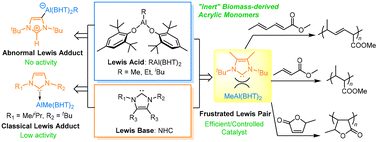
Polym. Chem., 2023,14, 3286-3293
https://doi.org/10.1039/D3PY00546A
Spatially resolved photoactivation of dynamic exchange reactions in 3D-printed thiol–ene vitrimers
On-demand photoactivation of dynamic transesterification in cross-linked thiol–ene polymers manufactured by digital light processing 3D printing.

Polym. Chem., 2023,14, 3082-3090
https://doi.org/10.1039/D3PY00377A
Allyl sulfides in garlic oil initiate the formation of renewable adhesives
Garlic essential oil (GEO) was used as the monomer, solvent and initiator to form adhesives. Analysis of GEO and the resulting polysulfide properties improved our understanding of poly(GEO) providing a route to develop renewable, S-based materials.
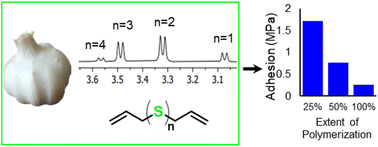
Polym. Chem., 2023,14, 3091-3098
https://doi.org/10.1039/D3PY00390F
Push–pull coumarin-based one-component iodonium photoinitiators for cationic nanocomposite 3D-VAT printing
In this article, we described a new group of cationic photoinitiators.
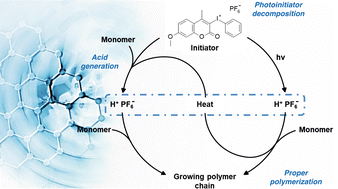
Polym. Chem., 2023,14, 3018-3034
https://doi.org/10.1039/D3PY00359K
Appropriate introduction of nitrile groups to balance NIR-II fluorescence imaging with photothermal therapy/photoacoustic imaging
Schematic illustration of nitrile-induced molecules enabling balance between NIR-II FLI and PTT/PAI.
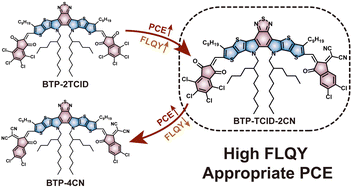
Polym. Chem., 2023,14, 3008-3017
https://doi.org/10.1039/D3PY00461A
Alkylborane initiated RAFT polymerization: impact of carboxylic acid deblockers
Oxygen-tolerant, alkylborane initiated RAFT has a partial order rate dependence of 1 for the acid concentration, supporting a homolytic substitution mechanism, and can be conducted with diminished deblocker concentrations when using stronger acids.

Polym. Chem., 2023,14, 2872-2877
https://doi.org/10.1039/D3PY00348E
Length-tuneable biocompatible block copolymer nanorods with a poly(2-methyl-2-oxazine)-corona via heat-induced crystallisation-driven self-assembly
Two new poly(2-isopropyl-2-oxazoline)-b-poly(2-methyl-2-oxazine) were prepared to investigate the relationship between total degree of polymerisation and heat-induced CDSA kinetics to prepare length-controlled biocompatible rod-shaped nanoparticles.
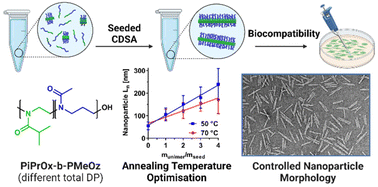
Polym. Chem., 2023,14, 2916-2929
https://doi.org/10.1039/D3PY00399J
An artificial neural network to predict reactivity ratios in radical copolymerization
An artificial neural network model is described which is capable of predicting reactivity ratios in radical copolymerization solely based on monomer chemical structures. It outperforms classical approaches, enabling prediction without kinetic data.
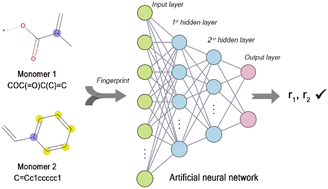
Polym. Chem., 2023,14, 2779-2787
https://doi.org/10.1039/D3PY00246B
Exploring SiliaCat Pd-DPP as a recyclable heterogeneous catalyst for the multi-batch direct heteroarylation polymerization for P(NDI2OD-T2)
Direct heteroarylation polymerization (DHAP) has been achieved for P(NDI2OD-T2) with a consistent molar mass using a modified A-B-A monomer and a recyclable heterogeneous SiliaCat Pd-DPP catalyst, for up to four consecutive reuses.
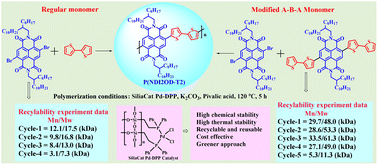
Polym. Chem., 2023,14, 2803-2819
https://doi.org/10.1039/D3PY00183K
Through-space charge transfer delayed fluorescence in tris(triazolo)triazine donor–acceptor copolymers
Donor–acceptor materials containing tris(triazolo)triazine (TTT) acceptors have recently gained attention as green to deep-blue fluorophores exhibiting thermally activated delayed fluorescence (TADF).

Polym. Chem., 2023,14, 2742-2749
https://doi.org/10.1039/D3PY00325F
Solvent-free, photoinduced block copolymer synthesis from polymerizable eutectics by simultaneous PET-RAFT and ring-opening polymerization in air
We report the preparation of thermoresponsive block copolymers via the simultaneous RAFT polymerization and anionic ring-opening polymerization (ROP) of N-isopropylacylamide and ε-caprolactone respectively, in the absence of traditional solvents.
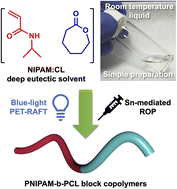
Polym. Chem., 2023,14, 2724-2733
https://doi.org/10.1039/D3PY00294B
Thermal annealing effects on the mechanical properties of bio-based 3D printed thermosets
3D printing technologies can address many sustainability aspects of creating new materials, such as reduced waste and on demand production, which reduces the carbon footprint of transport and storage.

Polym. Chem., 2023,14, 2697-2707
https://doi.org/10.1039/D3PY00200D
Polymer brush-grafted cellulose nanocrystals for the synthesis of porous carbon-coated titania nanocomposites
Polymer brush-grafted cellulose nanocrystals can be used as rod-like nanoreactors to produce carbon-coated titania nanocomposites for battery anodes.

Polym. Chem., 2023,14, 2181-2189
https://doi.org/10.1039/D3PY00194F
Synthesis of fluorescent poly(silyl indole)s via borane-catalyzed C–H silylation of indoles
A metal-free B(C6F5)3-catalyzed step-growth polymerization strategy is developed for the synthesis of fluorescent poly(silyl indole)s with novel polymeric frameworks through the regioselective dehydrogenation silylation of indoles.

Polym. Chem., 2023,14, 492-499
https://doi.org/10.1039/D2PY01470J
About this collection
Polymer Chemistry is proud to present this 2023 Pioneering Investigators collection. This collection highlights the great work being done by mid-career investigators who have firmly established themselves as pioneers of the field of polymer chemistry. Following the success of the 2021 Pioneering Investigators series, the Editorial and Advisory Boards of Polymer Chemistry and our previous Pioneering Investigators have personally recommended researchers who continuously publish creative, innovative work and have enriched several research areas.
New articles will be added to this collection as they are published.
Congratulations to all those whose work is featured. Join us in celebrating their contributions!